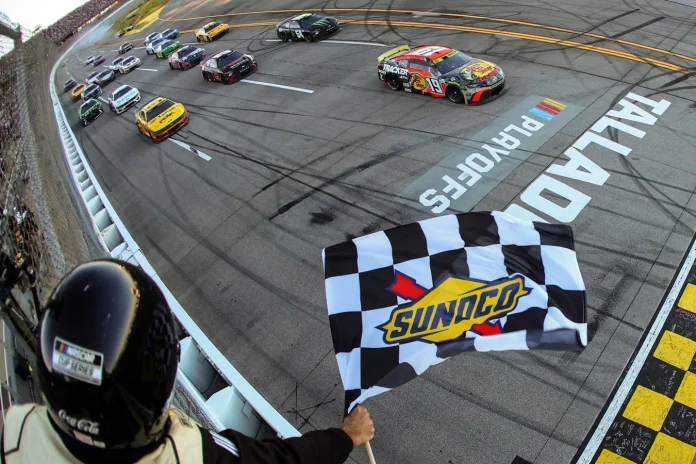The Brad Keselowski Talladega controversy has ignited debate across the NASCAR community following dramatic events at the YellaWood 500, where a sudden decline in Team Penske‘s performance stunned fans and analysts alike. As questions swirled about whether Keselowski was to blame for the unexpected collapse, new revelations from key figures have shed light on what truly happened during the pivotal race at Talladega.
Unexpected Developments at the YellaWood 500
This year’s YellaWood 500 introduced shockwaves right from qualifying, beginning with Michael McDowell capturing his second pole position of the 2025 campaign. Piloting the No. 71 Spire Motorsports car, McDowell posted an impressive lap at 182.466 mph, setting an early tone that hinted at unpredictability for the event. The surprises continued into the closing moments of the race itself, where the once-dominant Team Penske cars experienced a startling downfall in the final stage at Talladega Superspeedway.
Early in the race, Team Penske—bolstered by Cup Series champions Ryan Blaney and Joey Logano—appeared poised to secure another win. Blaney, the 2023 champion, and Logano, who won in 2022 and 2024, maintained strong positions throughout, entering the race’s decisive stage as frontrunners. Despite running second and third respectively, their performance quickly deteriorated, and they dropped outside the top 15 in just a short span, leaving spectators and teams scrambling for answers.
Inside the Penalty Box: Was Keselowski at Fault?
Speculation intensified in the aftermath as some within the powerhouse Penske squad pointed fingers at Brad Keselowski, co-owner of RFK Racing, for not providing the necessary draft push from behind. Accusations suggested Keselowski was conserving fuel by running at half throttle, a tactic that may have undermined Penske’s chances. However, closer examination of race telemetry, as well as insights from team insiders, suggest the situation is more nuanced than early rumors indicated.
TJ Majors, who serves as Keselowski’s spotter, offered a critical analysis during an episode of the Dale Jr. Download podcast. He asserted that the real turning point transpired when McDowell, driving the No. 34 machine, managed to take a clear lead in the outside lane. According to Majors, the result was out of Keselowski’s hands the moment the external draft broke conventional formations.
“The biggest mistake here is them letting the 34 get clear on the outside. From the time we took off, there was no lifting. Brad gets to Joey. He doesn’t lift…The only time that we start having to manage it is when we’re fourth in line on the bottom.”
– TJ Majors, Keselowski’s Spotter
Continuing his breakdown, Majors explained that McDowell’s approach as the new leader on the outside created additional challenges for the inside lane, which lost cohesion and speed as a result.
“The reason why the inside lane was fading once the 34 got there is because the 34 had not been up front all day. Yeah. He could not manage the gaps as good as Blaney and Joey could, and Brad that one time. He didn’t know. He’s not as refined at backing up and getting the push at the right spots.”
– TJ Majors, Keselowski’s Spotter
Reactions from the Paddock and Key Figures
Dale Earnhardt Jr. also weighed in, expressing surprise at the abrupt shift that affected Team Penske’s hopes at Talladega. He speculated that Penske’s drivers may have been caught off guard by a disjointed inside lane. As the outside line operated in a coordinated and streamlined fashion, the inside faltered due to inconsistent spacing and an overall lack of rhythm, deepening the frustration for Blaney and Logano.
Meanwhile, Jeremy Bullins, serving as Brad Keselowski’s Crew Chief, publicly defended his driver’s efforts during the controversial section of the race. He clarified that Keselowski was running at full throttle and did not back off intentionally to hinder Team Penske’s prospects.
The Role of Michael McDowell and Changing Dynamics
Michael McDowell’s own comments added an additional layer to the developing story. Speaking on his performance and interactions with playoff contenders, McDowell stated:
“When it comes to playoff contenders, you do think about them at most of the races but not Talladega,”
– Michael McDowell, Driver No. 71 Spire Motorsports
Despite lacking overall race pace—as shown by his 17th-place finish—McDowell maintained an aggressive approach, influencing the outcome for top competitors like Team Penske. His decision to push hard, regardless of playoff implications, contributed significantly to the late-race turbulence that ultimately reshaped the event’s outcome at Talladega.
Implications for Team Penske and NASCAR’s Playoff Picture
The fallout from this incident raises significant questions for Team Penske’s championship hopes, highlighting the razor-thin margins and strategic risks integral to superspeedway events. As accusations fade and clarity emerges, the spotlight remains fixed on how teams—and drivers such as Brad Keselowski—will adapt in the face of rapidly changing race conditions and unexpected challenges. With NASCAR’s playoff season intensifying, every decision on track carries substantial weight as the push for the Cup title continues.



